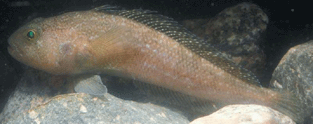Biology

Fish in the Bellingshausen Sea
The Bellingshausen Sea is a remote part of the ocean surrounding the Antarctic, isolated, inhospitable and almost unexplored. A Hespérides expedition has managed to study the fauna which inhabit this region. Examples of 23 species of fish have been studied and at present we are in the process of discovering more species.
References
"Fishes of the Bellingshausen Sea and Peter I Island". Matallanas, J; Olaso, I. POLAR BIOLOGY, eFIRST date: 5 OCT 2006. 2007, 30:333-341.
Many studies on animal biodiversity have been carried out by members of the Zoology Unit (Biosciences) since the beginnings of the UAB. One of the most recent has been that of Dr. Jesús Matallanas, who has participated as an expert in fish taxonomy in Antarctic campaigns undertaken by the Hespérides in the Bellingshausen Sea.
Up to now, the ictiofauna of this sea was unknown. The fish were caught with a Agassiz dredge net and baited bag nets, at depths of between 355 and 1947 m. The results, in collaboration with Dr I. Olaso, from the Spanish Institute of Oceanography have just been published in the latest edition of the German journal Polar Biology.
The aim of the work was to discover the taxonomic composition of the ictiofauna of this sea, the abundance of the distinct species and their zoogeographic affinities. 23 species were found in the sea. The dominant families are Zoarcidae and Nototheniidae: 98 % of the examples captured (52 % in weight) belong to species of these two families. Nevertheless, the means of capture of these two species differs; 98 % of the Nototheniidae were caught with the Agassiz dredge net, while 97 % of the Zoarcidae were caught with baited bag nets.
Various Zoarcidae.
A widely held opinion is that Antarctic ictiofauna is dominated by Nototheniidae. However in the Bellingshausen Sea, the dominant group is Zoarcidae, which exceeds Nototheniidae in number and almost triples it in weight. As regards the batimetric distribution we should point out that at depths of less than 550 m, Nototheniidae dominate with 73 % of the examples, followed by Zoarcidae (18 %); below this depth, 76 % of the examples belong to Zoarcidae, while Nototheniidae hardly exceeds 2 %.
In spite of the lack of knowledge we had of the Bellingshausen Sea it has been repeatedly included in the Western Antarctic Province. However, from an ictiogeographic point of view we have not discovered any species which are characteristic of that province. On the contrary, its ictiofauna is more similar to that of the Ross Sea and the Weddell Sea and, therefore, it would fit better in the Eastern Antarctic Province.
Most of the Zoarcidae captured in the Bellingshausen Sea belong to species never before described. The author is at present working on just such a taxonomic study.
Jesús Matallanas
Department of Animal Biology, Plant Biology and Ecology
Universitat Autònoma de Barcelona
2024 Universitat Autònoma de Barcelona
B.11870-2012 ISSN: 2014-6388
